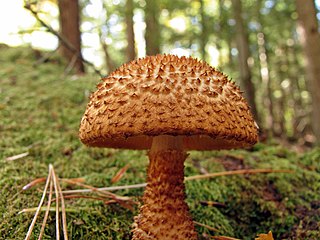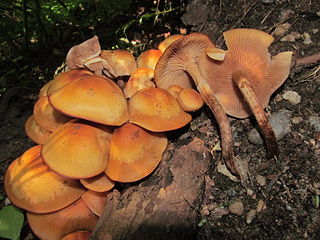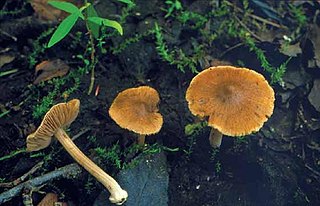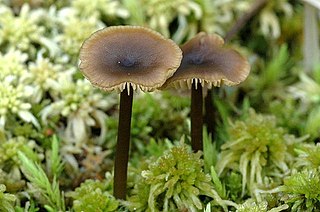
Armillaria is a genus of fungi that includes the A. mellea species known as honey fungi that live on trees and woody shrubs. It includes about 10 species formerly categorized summarily as A. mellea. Armillarias are long-lived and form the largest living fungi in the world. The largest known organism covers more than 3.4 square miles (8.8 km2) in Oregon's Malheur National Forest and is estimated to be 2,500 years old. Some species of Armillaria display bioluminescence, resulting in foxfire.

Armillaria mellea, commonly known as honey fungus, is an edible basidiomycete fungus in the genus Armillaria. It is a plant pathogen and part of a cryptic species complex of closely related and morphologically similar species. It causes Armillaria root rot in many plant species and produces mushrooms around the base of trees it has infected. The symptoms of infection appear in the crowns of infected trees as discoloured foliage, reduced growth, dieback of the branches and death. The mushrooms are edible but some people may be intolerant to them. This species is capable of producing light via bioluminescence in its mycelium.

Sphagnum is a genus of approximately 380 accepted species of mosses, commonly known as sphagnum moss, also bog moss and quacker moss. Accumulations of Sphagnum can store water, since both living and dead plants can hold large quantities of water inside their cells; plants may hold 16 to 26 times as much water as their dry weight, depending on the species. The empty cells help retain water in drier conditions.

Pholiotina smithii is a rare member of the genus Pholiotina which contains the hallucinogenic alkaloid psilocybin. It was formerly known as Galera cyanopes.

Armillaria luteobubalina, commonly known as the Australian honey fungus, is a species of mushroom in the family Physalacriaceae. Widely distributed in southern Australia, the fungus is responsible for a disease known as Armillaria root rot, a primary cause of Eucalyptus tree death and forest dieback. It is the most pathogenic and widespread of the six Armillaria species found in Australia. The fungus has also been collected in Argentina and Chile. Fruit bodies have cream- to tan-coloured caps that grow up to 10 cm (4 in) in diameter and stems that measure up to 20 cm (8 in) long by 1.5 cm (1 in) thick. The fruit bodies, which appear at the base of infected trees and other woody plants in autumn (March–April), are edible, but require cooking to remove the bitter taste. The fungus is dispersed through spores produced on gills on the underside of the caps, and also by growing vegetatively through the root systems of host trees. The ability of the fungus to spread vegetatively is facilitated by an aerating system that allows it to efficiently diffuse oxygen through rhizomorphs—rootlike structures made of dense masses of hyphae.

Aulacomnium palustre, the bog groove-moss or ribbed bog moss, is a moss that is nearly cosmopolitan in distribution. It occurs in North America, Hispaniola, Venezuela, Eurasia, and New Zealand. In North America, it occurs across southern arctic, subboreal, and boreal regions from Alaska and British Columbia to Greenland and Quebec. Documentation of ribbed bog moss's distribution in the contiguous United States is probably incomplete. It is reported sporadically south to Washington, Wyoming, Georgia, and Virginia.

Craterellus tubaeformis is an edible fungus, also known as yellowfoot, winter mushroom, or funnel chanterelle. It is mycorrhizal, forming symbiotic associations with plants, making it very challenging to cultivate. It is smaller than the golden chanterelle and has a dark brown cap with paler gills and a hollow yellow stem. C. tubaeformis tastes stronger but less fruity than the golden chanterelle. It has a very distinctive smokey, peppery taste when raw. It grows in temperate and cold parts of Northern America and Europe, including Scandinavia, Finland, Russia, and the British Isles, as well as in the Himalayas in Asia, including Assam, in the central parts of the Indian subcontinent, and in Thailand.

Mythicomyces is a fungal genus in the family Mythicomycetaceae. A monotypic genus, it contains the single species Mythicomyces corneipes, first described by Elias Fries in 1861. The fungus produces fruit bodies with shiny yellowish-orange to tawny caps that are 1–3 cm (0.4–1.2 in) in diameter. These are supported by stems measuring 2–5.7 cm (0.8–2.2 in) long and 1–2 mm thick. A rare to uncommon species, it is found in northern temperate regions of North America and Europe, where it typically fruits in groups, in wet areas of coniferous forests. There are several species with which M. corneipes might be confused due to a comparable appearance or similar range and habitat, but microscopic characteristics can be used to reliably distinguish between them.

Armillaria gallica is a species of honey mushroom in the family Physalacriaceae of the order Agaricales. The species is a common and ecologically important wood-decay fungus that can live as a saprobe, or as an opportunistic parasite in weakened tree hosts to cause root or butt rot. It is found in temperate regions of Asia, North America, and Europe. The species forms fruit bodies singly or in groups in soil or rotting wood. The fungus has been inadvertently introduced to South Africa. Armillaria gallica has had a confusing taxonomy, due in part to historical difficulties encountered in distinguishing between similar Armillaria species. The fungus received international attention in the early 1990s when an individual colony living in a Michigan forest was reported to cover an area of 15 hectares, weigh at least 9.5 tonnes, and be 1,500 years old. This individual is popularly known as the "humongous fungus", and is a tourist attraction and inspiration for an annual mushroom-themed festival in Crystal Falls. Recent studies have revised the fungus's age to 2,500 years and its size to about 400 tonnes, four times the original estimate.

Leucopholiota decorosa is a species of fungus in the mushroom family Tricholomataceae. Commonly known as the decorated pholiota, it is distinguished by its fruit body which is covered with pointed brown, curved scales on the cap and stem, and by its white gills. Found in the eastern United States, France, and Pakistan, it is saprobic, growing on the decaying wood of hardwood trees. L. decorosa was first described by American mycologist Charles Horton Peck as Agaricus decorosus in 1873, and the species has been transferred to several genera in its history, including Tricholoma, Tricholomopsis, Armillaria, and Floccularia. Three American mycologists considered the species unique enough to warrant its own genus, and transferred it into the new genus Leucopholiota in a 1996 publication. Lookalike species with similar colors and scaly fruit bodies include Pholiota squarrosoides, Phaeomarasmius erinaceellus, and Leucopholiota lignicola. L. decorosa is considered an edible mushroom.

Armillaria nabsnona is a species of fungus in the family Physalacriaceae. The species is found in the west coast of North America, Hawaii, and Japan, where it grows on decaying hardwoods, particularly species of alder. Its fruit bodies have convex to flattened orange-brown caps up to 7 cm in diameter, brown stipes, and whitish to pinkish-tan gills.

Mycena epipterygia is a species of fungus in the family Mycenaceae of mushrooms commonly found in Europe. It is commonly known as yellowleg bonnet or yellow-stemmed mycena. The species is saprotrophic and its appearance is quite variable. For example, a number of members of the genus Mycena, some parts of the fungus are bioluminescent, including in this species, the mycelium. Mycena nivicola has been suggested as a separate species name for the Western variety.

Amanita atkinsoniana, also known as the Atkinson's amanita, is a species of fungus in the family Amanitaceae. The fruit body is white to brownish, with caps up to 12.5 centimetres in diameter, and stems up to 20 cm long. The surface of the cap is covered with brownish conical warts.

Armillaria ostoyae is a species of fungus (mushroom), pathogenic to trees, in the family Physalacriaceae. In the western United States, it is the most common variant of the group of species under the name Armillaria mellea. A. ostoyae is common on both hardwood and conifer wood in forests west of the Cascade Range in Oregon, United States. It has decurrent gills and the stipe has a ring. The mycelium invades the sapwood and is able to disseminate over great distances under the bark or between trees in the form of black rhizomorphs ("shoestrings"). In most areas of North America, Armillaria ostoyae can be separated from other species by its physical features: cream-brown colors, prominent cap scales, and a well-developed stem ring distinguish it from other Armillaria. Like several other Armillaria, the mycelium of Armillaria ostoyae can display bioluminescence, resulting in foxfire.

Inocybe saliceticola is a fungus found in moist habitats in the Nordic countries. The species produces brown mushrooms with caps of varying shapes up to 40 millimetres (1.6 in) across, and tall, thin stems up to 62 mm (2.4 in) long. At the base of the stem is a large and well-defined "bulb". The species produces unusually shaped, irregular spores, each with a few thick protrusions. This feature helps differentiate it from other species that would otherwise be similar in appearance and habit.

Lepiota castaneidisca is a species of agaric fungus in the family Agaricaceae. Formally described in 1912, it was for a long time considered the same species as the similar Lepiota cristata until molecular analysis reported in 2001 demonstrated that it was genetically distinct. It is most common in coastal and northern California, and has also been recorded in Mexico. A saprobic species, it is usually found under redwood and Monterey cypress. Its fruit bodies (mushrooms) have white caps with an orange-red to orange-brown center that measure up to 3.2 cm (1.3 in) wide. The cream-colored to light pink stems are up to 6.5 cm (2.6 in) long by 0.2–0.6 cm (0.1–0.2 in) thick, and have a ring. L. castaneidisca can be distinguished from other similar Lepiota species by differences in habitat, macroscopic, or microscopic characteristics.

Tricholoma vernaticum is an agaric fungus of the genus Tricholoma native to the Pacific Northwest region of the United States. The fungus was originally described in 1976 as a species of Armillaria when that genus was more inclusive; it received its current name twenty years later. The stout fruit bodies (mushrooms) have moist white to grayish caps, a membranous ring on the stipe, and an odor resembling cucumbers. Mycorrhizal with conifers, the fungus fruits in the spring or early summer, with its mushrooms appearing on the ground singly or in groups at high elevations, often at the edge of melting snowbanks. The edibility of the mushroom is unknown, but it has a strong unpleasant odor and a mealy taste.

Sphagnurus paluster is a species of fungus in the family Lyophyllaceae which parasitizes Sphagnum moss. It was first described by Charles Horton Peck in 1872. It is commonly called the sphagnum greyling due to it being found in peat bogs and to its cap turning grey as it ages and dries.

Trichophorum cespitosum, commonly known as deergrass or tufted bulrush, is a species of flowering plant in the sedge family. It was originally described by the Swedish naturalist Carl Linnaeus in 1753 as Scirpus cespitosus, but was transferred to the genus Trichophorum by the Swedish botanist Carl Johan Hartman in 1849, becoming Trichophorum cespitosum.

Sphagnum papillosum, the papillose peatmoss, is a species of peat moss distributed throughout the northern hemisphere. Although sometimes confused with Sphagnum imbricatum and Sphagnum palustre, it is distinguished by its yellow-green to brown short, blunt branches and papillose chlorophyllose cells.




















